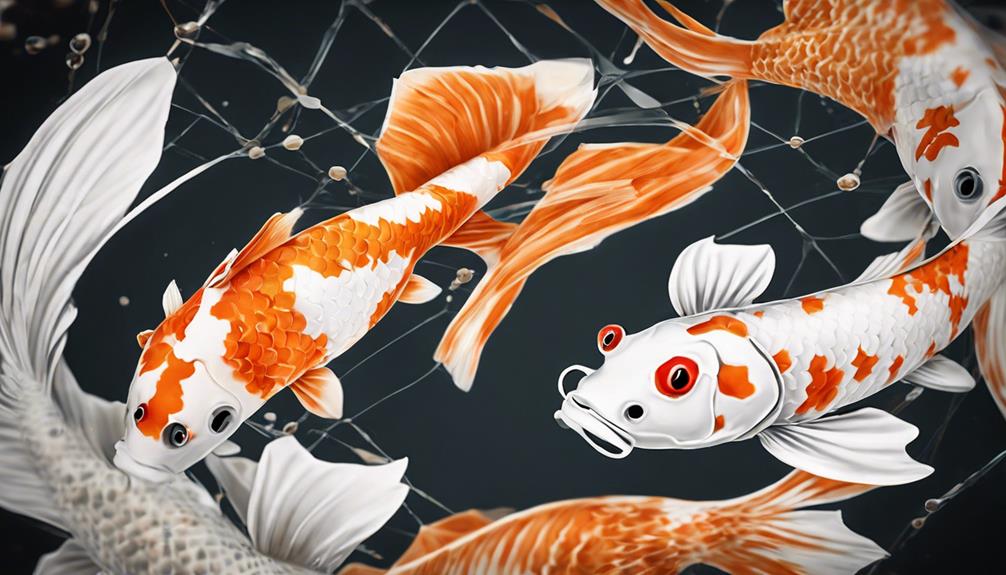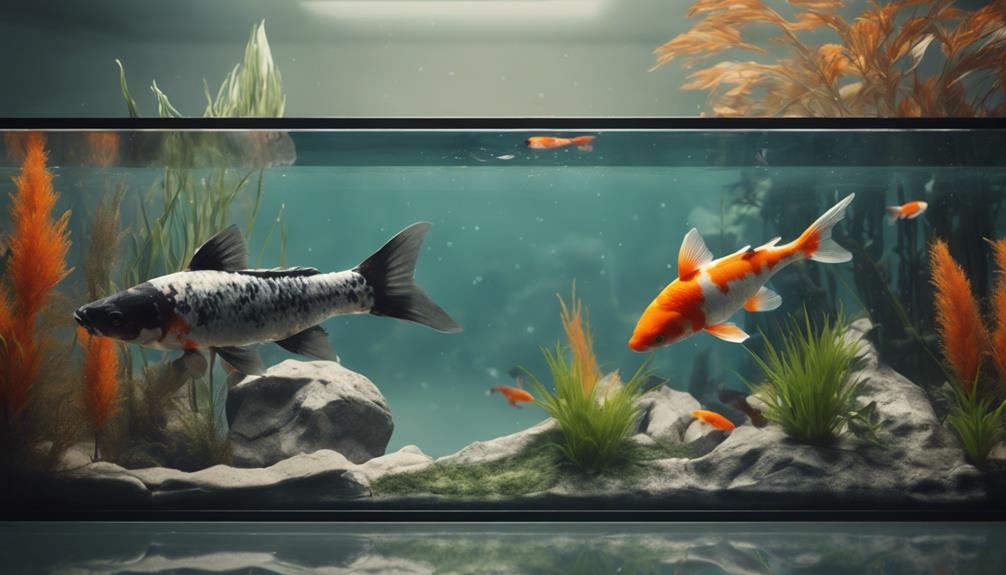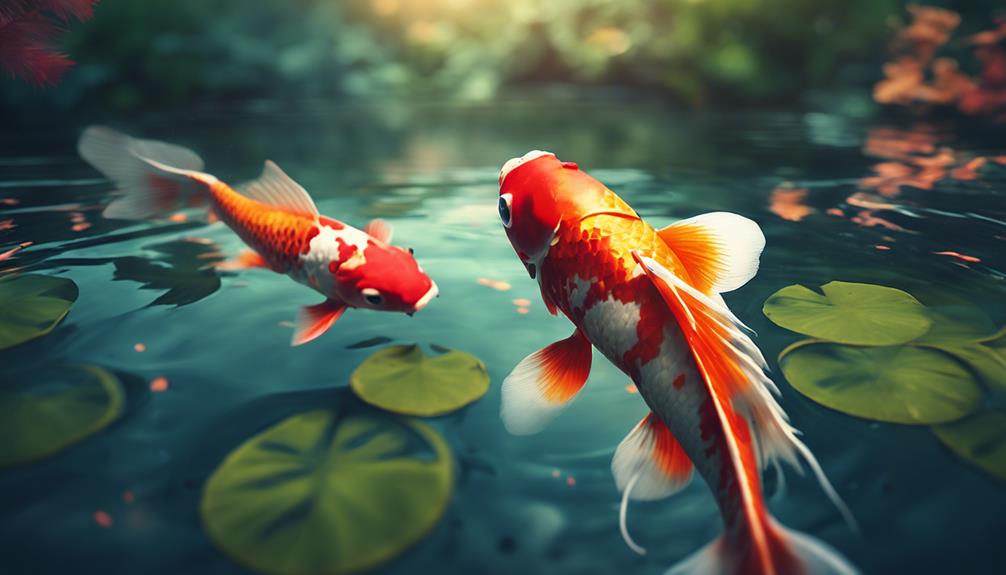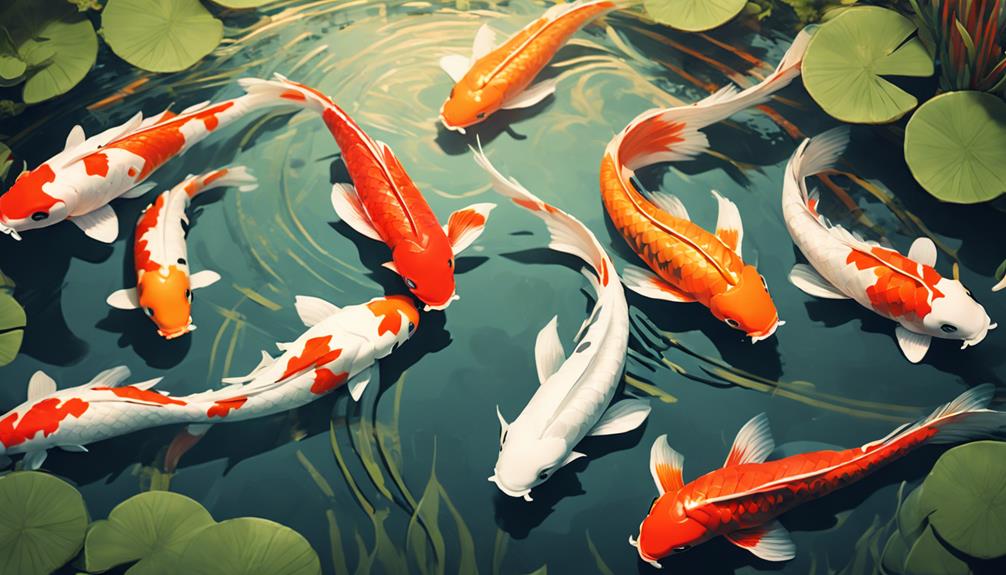You've selectively bred koi to showcase vibrant colors and unique patterns, thanks to the meticulous control of genetic and environmental factors through precise breeding methods. Linebreeding intensifies desired characteristics, such as vibrant colors, while culling removes fish with undesirable traits. Genetic testing identifies genes associated with desired colors and patterns. Breeding techniques like step-breeding achieve specific characteristics in each generation. Understanding the intricate interplay of genes, environment, and nutrition allows breeders to predict and manipulate color expression. As you explore the world of koi breeding, you'll uncover the fascinating science behind these stunning colors.
Table of Contents
Key Takeaways
- Selective breeding techniques, like linebreeding and culling, help intensify desired colors and patterns in koi.
- Genetic testing using DNA analysis identifies genes associated with vibrant colors, enabling breeders to make informed decisions.
- Breeding for specific characteristics, such as vibrant red or white, requires careful selection and refinement over generations.
- The interaction of multiple color genes determines the final color pattern, making breeding a complex process.
- Understanding gene interaction enables breeders to predict and manipulate color expression, resulting in vibrant koi colors.
History of Koi Breeding
As you explore into the world of koi, you'll discover that the art of breeding these vibrant fish has a rich history.
Since the 17th century, Japanese breeders have selectively bred koi to accentuate desirable traits, leading to the development of over 100 recognized varieties.
Through careful selection and breeding techniques, they've created an astonishing array of colors, patterns, and fin shapes.
You'll find that young koi, in particular, are bred to exhibit specific characteristics, which are then refined as they mature.
The history of koi breeding is a reflection to human ingenuity and dedication.
By understanding the breeding process, you'll gain a deeper appreciation for the intricate beauty of these fish.
From the metallic sheen of the Ogon variety to the bold stripes of the Kohaku, each type of koi carp is a result of deliberate breeding decisions.
As you explore the world of koi, you'll become part of a community that values precision, patience, and a passion for these magnificent creatures.
Symbolism Behind Koi Colors
As you explore the symbolism behind koi colors, you'll notice that interpretations vary widely.
You'll find that different cultures have assigned unique meanings to specific colors, reflecting their distinct histories and values.
Color Interpretations Vary
You'll find that the symbolism behind koi colors varies across cultures, with different societies assigning unique meanings to specific hues. This variation is rooted in the diverse histories and mythologies of each culture. Breeders can create vibrant colors and unique color patterns through selective breeding, but the meaning behind these colors is subjective. For instance, a koi with a red and white color combination may symbolize good luck in one culture, while representing love and energy in another.
| Color Trait | Meaning in Japanese Culture | Meaning in Chinese Culture |
|---|---|---|
| Red | Energy, passion | Good luck, prosperity |
| White | Purity, innocence | Good fortune, happiness |
| Black | Protection, mystery | Wisdom, power |
| Yellow | Happiness, wealth | Royalty, honor |
| Orange | Creativity, playfulness | Abundance, joy |
As you explore the world of koi, crucial to grasp is that color interpretations vary. While breeders can create stunning color combinations, the symbolism behind these colors is unique to each culture.
Symbolism Across Cultures
As you explore into the world of koi, you'll discover that their vibrant colors hold distinct symbolic meanings across cultures.
Koi colors hold distinct symbolic meanings across cultures, with each society attributing unique significance to specific hues. In Japan, red coloration symbolizes good luck, prosperity, and energy, while white coloration represents purity and innocence. On the other hand, black coloration is associated with good health, wisdom, and spirituality.
Interestingly, these symbolic meanings vary across cultures. In China, koi are considered ornamental fish, symbolizing wealth and good fortune. The Vietnamese believe that koi varieties with specific color patterns can bring prosperity and good luck to their owners. In some cultures, koi are even seen as a status symbol, with certain colors and patterns reserved for the upper class.
As you explore the world of koi, you'll begin to appreciate the rich cultural significance behind their colors. By understanding the symbolism behind these colors, you'll gain a deeper appreciation for the art of koi breeding and the cultural heritage surrounding these magnificent creatures.
Genetics of Color Inheritance

As you explore the genetics of color inheritance in koi, you'll discover that it's a complex interplay of genes that determines the final coloration of these fish.
You'll find that specific genes interact with each other in unique ways to produce the vibrant colors we see.
Color Gene Interaction
When you explore into the world of koi breeding, you'll discover that the interaction of multiple color genes determines the final color pattern, with each gene influencing the expression of others to produce a wide range of vibrant hues.
This complex genetic makeup leads to incredible color variations, making each koi unique.
The pigments responsible for these colors are melanin, carotenoids, and pteridines, which combine in different ways to create the stunning patterns we see.
A single gene can have a significant impact on the final coloration, but it's the interaction between multiple genes that truly brings koi coloration to life.
By understanding how these genes interact, breeders can predict and manipulate the expression of different Color Varieties.
For instance, the introduction of a specific gene can enhance or suppress certain colors, resulting in new and exciting patterns.
As you explore the world of koi breeding, you'll come to appreciate the intricate dance of genetic factors that come together to create these living works of art.
Inheritance Patterns
You'll find that the inheritance patterns of koi color genes follow the principles of Mendelian genetics, where the random combination of alleles from parent fish determines the color traits expressed in their offspring. This means that koi breeders can predict the probability of certain color traits being passed down to the next generation. For instance, when breeding for vibrant Gin Rin scales, breeders need to understand how the genes controlling this trait are inherited.
| Genotype | Phenotype | Probability |
|---|---|---|
| BB or Bb | Black | 75% |
| bb | Non-black | 25% |
| RR or Rr | Red | 75% |
| rr | Non-red | 25% |
| GG or Gg | Gin Rin | 75% |
Environmental Factors at Play
Environmental conditions surrounding your koi pond, including water temperature, quality, and light exposure, substantially influence the vibrancy of your koi's colors.
As a koi enthusiast, you understand the importance of creating a favorable environment for your fish to flourish.
Water quality, in particular, plays a critical role in enhancing or diminishing your koi's colors.
A stable pH range between 6.5 and 8.5 guarantees your koi can absorb nutrients effectively, which in turn, supports vibrant coloration.
Good water quality, characterized by low ammonia and nitrite levels, prevents stress and promotes healthy scales that reflect light, resulting in more vivid colors.
Adequate sunlight or artificial lighting stimulates your koi's color pigments, making them more pronounced and intense, allowing you to deliberate the best approach for your koi's well-being.
Nutrition and Diet Impact

As you deliberate the best approach for your koi's well-being, you must consider the profound impact of nutrition and diet on the vibrancy of their colors, since a well-balanced diet provides the essential nutrients for ideal growth and color expression.
A diet rich in carotenoids, such as spirulina and krill, can enhance the expression of reds, oranges, and yellows in orange koi fish, resulting in a vibrant and diverse range of color.
Conversely, a lack of these nutrients can lead to dull or washed-out colors.
It's also vital to avoid overfeeding, which can lead to poor water quality and negatively impact koi coloration.
Underfeeding, on the other hand, can cause stress, leading to changes in behavior and appearance.
By providing a nutrient-rich diet that includes live foods, such as brine shrimp and bloodworms, you can promote healthy, vibrant coloration in your koi.
Additionally, some foods, like garlic and paprika, are believed to have a positive impact on color intensity.
Health and Wellness Effects
Your koi's health and wellness play a critical role in maintaining their vibrant colors, since underlying health issues can lead to dull, faded, or uneven coloration.
As a responsible koi breeder, prioritizing your fish's overall health is vital to guarantee their colors remain vibrant and stunning.
Genetic predispositions: Some koi breeds, like the black and white Kohaku, are more prone to color dullness due to genetic factors. Understanding the breeding history of your koi can help you identify potential health risks.
Environmental stressors: Exposure to pollutants, poor water quality, or extreme temperature fluctuations can cause stress, leading to color changes. Regular water testing and maintenance can help mitigate these risks.
Nutrient deficiencies: A diet lacking essential nutrients, such as vitamin C or beta-carotene, can affect your koi's color intensity. Make certain your koi receive a balanced diet that meets their nutritional needs.
Seasonal Changes and Growth

Seasonal changes and growth spurts can markedly impact your koi's color vibrancy, with some breeds exhibiting more pronounced color shifts during certain times of the year.
As you observe your stunning koi, you may notice that their colors become more intense or muted in response to temperature fluctuations, daylight hours, and nutrient availability.
This is because koi varieties have adapted to their natural environments over a long time, developing unique growth patterns and color responses to their surroundings.
During periods of rapid growth, your koi's coloration may appear more vibrant, especially in breeds that exhibit a wide range of colors.
For instance, certain koi may display deeper reds or blues during the summer months when water temperatures are warmer.
Conversely, as the water cools, their colors may become less intense or more muted.
Understanding these seasonal changes is essential for creating an ideal environment that supports your koi's growth and color development.
Breeding Methods and Techniques
Through selective breeding, koi breeders have developed over 100 varieties of koi, each with unique colors and patterns, by employing techniques like linebreeding, inbreeding, and outbreeding to achieve desired traits.
As you explore the world of koi breeding, you'll discover that breeders use various methods to produce vibrant colors and patterns. For instance, the popular Kohaku koi is bred using a process called 'step-breeding,' where breeders select for specific characteristics in each generation to achieve the desired pattern and color.
Linebreeding: This involves breeding koi with similar genetic traits to intensify desired characteristics, such as vibrant colors.
Culling: Breeders remove fish with undesirable traits from the breeding process to guarantee only the healthiest and most vibrant fish are used to produce the next generation.
Genetic testing: This involves using DNA analysis to identify specific genes associated with desired colors and patterns, allowing breeders to make more informed breeding decisions.
Frequently Asked Questions
What Determines the Color of Koi Fish?
You'll discover that the color of koi fish is determined by a combination of genetic predisposition, environmental factors like diet influences and water quality, as well as the unique structure of their scales and pigment distribution.
How to Make Koi Color Brighter?
You can enhance your koi's color vibrancy by focusing on ideal fish nutrition, maintaining exceptional water quality, and utilizing advanced breeding techniques backed by genetics research, as well as incorporating targeted food supplements for color enhancement.
What Is the Rarest Koi Color?
You're curious about the rarest koi color, and it's a fascinating topic. The rarest colors result from low color mutation rates, unique genetic anomalies, and intricate breeding secrets, which affect color intensity variation and produce exceptional, one-of-a-kind patterns.
What Type of Inheritance Influences the Coloration of Koi?
You'll be fascinated to know that 75% of koi color variations are attributed to genetic factors. When it comes to koi coloration, you're dealing with Mendelian genetics, Polygenic traits, Epistatic interactions, Genetic drift, and Linkage analysis, all influencing Heritability estimates.
Conclusion
As you gaze into the kaleidoscope of colors dancing across your koi's scales, remember that their vibrant hues are a delicate balance of art and science.
Breeding methods are the masterful brushstrokes that bring out the full spectrum of colors, while genetics, environment, nutrition, and health are the subtle nuances that refine the masterpiece.
By understanding the intricate dance between these factors, you can reveal the secrets to breeding koi that shimmer like jewels in the sunlight.

